Grab and Taxi in Vietnam: Best transport options for visitors
When visiting Vietnam, you're faced with countless transportation options. But when it comes to convenience, affordability and safety, Grab and Taxi in Vietnam stand out as the top choices for locals and tourists alike. While traditional taxis have long been a staple of Vietnamese urban life, Grab - a Southeast Asian ride-hailing giant - has rapidly transformed how people get around cities like Hanoi and Ho Chi Minh City.
In a bustling, often chaotic traffic environment, having a reliable means of transport is a must. That’s where this guide comes in - here to offer you the inside scoop on navigating both taxis and Grab rides, saving money, staying safe and traveling smarter. So buckle up - we’re about to drive straight into the heart of Vietnam’s urban mobility scene.
- Introduction to transportation in Vietnam
- Comparing Grab vs traditional taxis
- Cost breakdown: Grab vs taxis in Vietnam
- Booking a ride via Grab App
- How to hail a taxi in Vietnam
- Popular Grab services available
- Top taxi companies in Vietnam
- Similar brands to Grab in Vietnam: Be and Xanh SM
- Airport transfers: Grab or Taxi?
- Language barrier issues
- Using GrabPay and payment options
- Best cities for using Grab in Vietnam
- Alternatives to grab and taxis
- Conclusion: Grab and Taxi in Vietnam
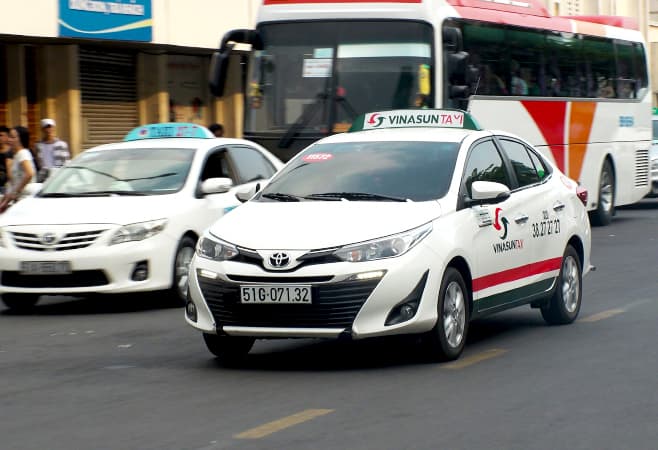
Vinasun taxi at the street - Famous taxi company in Vietnam
Introduction to transportation in Vietnam
Vietnam’s transportation landscape is dynamic, diverse and a little dizzying. From bustling motorbike-packed streets to sleepy rural lanes, how people move around here tells you a lot about the country itself.
In the big cities, you'll see motorbikes dominating the roads, accounting for over 80% of all vehicles. But for those not ready to hop on two wheels, taxis and Grab cars offer a more comfortable (and less heart-racing) alternative. Public buses exist and are improving, but they often fall short in terms of convenience and user-friendliness for travelers unfamiliar with the local language.
As Vietnam continues to modernize, app-based ride services like Grab are filling in the gaps left by traditional transportation, making it easier than ever for tourists to navigate the vibrant Vietnamese landscape.
Comparing Grab vs traditional taxis
| Feature | Grab | Traditional Taxi |
| Pricing transparency | Fixed upfront price | Metered, can vary |
| Payment options | Cash, credit card, e-wallets | Mostly cash, credit card |
| Booking convenience | App-based, GPS tracking | Street hailing or hotline |
| Scam likelihood | Very low | Occasionally overcharges |
| Language barrier | App handles destination | May require Vietnamese |
| Availability | Depends on internet/signal | Often found near hotels/stations |
Overall, Grab wins on tech-savviness and convenience, while taxis are better for spontaneous, offline travel - especially in areas with poor mobile data coverage.
Cost breakdown: Grab vs taxis in Vietnam
When it comes to the cost of getting around, Grab and Taxi in Vietnam offer two very different approaches to pricing.
Grab’s pricing model:
Grab calculates its fare based on distance, time and sometimes demand (surge pricing). However, users see the final price before confirming the ride, offering complete transparency. This predictability is one of the app’s strongest appeals, especially for foreigners worried about being overcharged.
Taxi pricing model:
Traditional taxis operate on a meter system. Prices start with a base fare - usually around 10,000 to 15,000 VND (approximately $0.40 to $0.60 USD) - and increase with distance. If you're caught in traffic, the meter keeps running and so does your bill. In areas with high tourist footfall, some drivers may “forget” to turn on the meter or take longer routes, which can inflate costs.
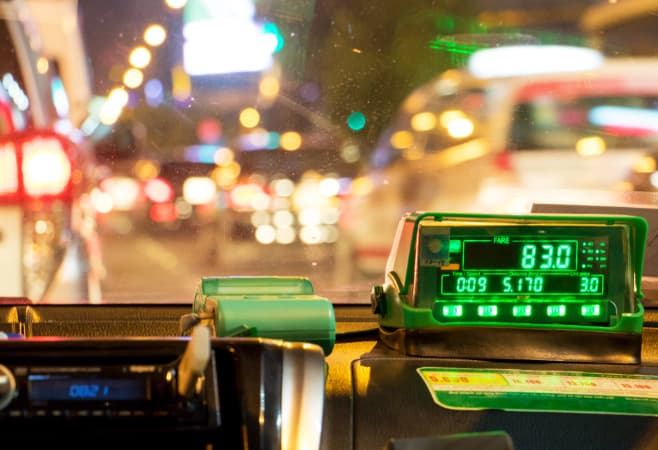
The digital taxi meter on the dashboard of cab shows kilometers and cost
Here’s a quick comparison chart for reference:
| Distance | Grab (Estimated in VND) | Traditional Taxi (Estimated in VND) |
| 2 km | 22,000 - 25,000 | 30,000 - 35,000 |
| 5 km | 45,000 - 50,000 | 60,000 - 70,000 |
| 10 km | 80,000 - 100,000 | 120,000 - 150,000 |
These figures may vary depending on the city and time of day. But overall, Grab tends to be more economical and tourist-friendly.
Booking a ride via Grab App
If you're new to the ride-hailing world, using the Grab app in Vietnam is incredibly simple. Here's how to get started:
Step-by-step guide:
- Download the App: Available on Google Play and Apple Store.
- Sign Up: Use your phone number or email. Grab may send a verification code.
- Enable Location Services: Grab needs to access your GPS to find your pickup point.
- Enter Destination: Input your drop-off location in the “Where to?” box.
- Select a Service: Choose from GrabBike, GrabCar, or GrabTaxi.
- Review Fare and Confirm: See the price, estimated time and route before you tap "Book".
Pro tip:
Use promo codes (often displayed in the app) to enjoy discounts. If you're using a foreign SIM card, ensure your data plan is active, or connect to Wi-Fi.
How to hail a taxi in Vietnam
Despite the rise of Grab, taxis still rule the streets, especially in areas with spotty mobile coverage. Hailing a taxi the traditional way isn’t difficult - you just need to follow some practical advice.
Where to find taxis:
- Outside airports, hotels and malls
- Near tourist hotspots and public transport terminals
- By calling major taxi company hotlines (some even speak basic English)
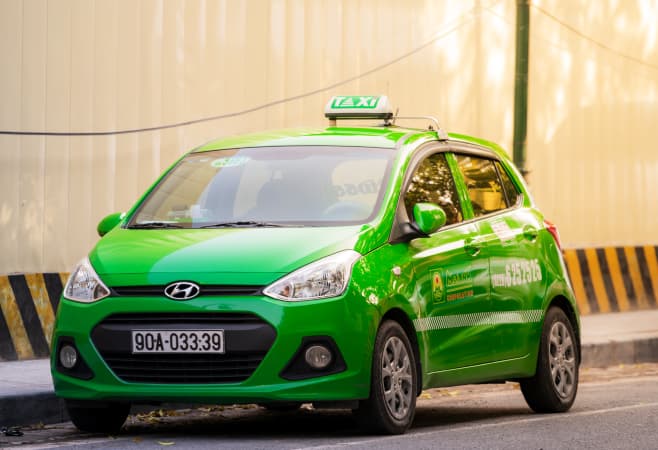
A Mai Linh green taxi cab sits in the streets
Tips for hailing a taxi safely:
- Look for branded taxis like Mai Linh (green) or Vinasun (white with red/green stripes)
- Always check that the meter is turned on
- Avoid unbranded, “freelance” taxis unless you're with a local
Taxi hotline numbers in major cities:
| City | Taxi Company | Hotline |
| Ho Chi Minh City | Vinasun | (028) 38 27 27 27 |
| Ha Noi | Mai Linh | (024) 38 61 61 61 |
| Da Nang | Tien Sa Taxi | (0236) 3 79 79 79 |
Popular Grab services available
Grab isn’t just a one-trick pony. The platform has diversified its offerings to cater to all kinds of travel needs in Vietnam.
Main ride services:
- Grabcar: Standard 4-seat or 7-seat cars for a comfortable trip.
- Grabbike: A motorbike taxi, cheaper and faster during rush hours.
- Grabtaxi: Hails a traditional taxi through the Grab app with metered pricing.
- Grabshare: Share rides with strangers to save costs.
- Grabexpress: Motorbike courier service, useful for quick deliveries.
If you're traveling alone and in a hurry, GrabBike is unbeatable. For families or business travelers, GrabCar offers the comfort and space required.
Top taxi companies in Vietnam
If you prefer taxis, stick to the reputable ones. Here’s a quick breakdown of the most trusted brands:
Vinasun Taxi
- Pros: Professional drivers, GPS meters, clean cars
- Cons: Slightly higher fares than local taxis
Mai Linh Taxi
- Pros: Nationwide presence, English-speaking hotline
- Cons: Service may vary between cities
Saigon Tourist Taxi
- Pros: Well-maintained vehicles
- Cons: Mainly operates in HCMC
Tien Sa Taxi
- Pros: Dominant in Da Nang and central provinces
- Cons: Less known outside central Vietnam
Avoid independent taxis or unbranded vehicles, especially late at night or in remote areas.
Similar brands to Grab in Vietnam: Be and Xanh SM
While Grab remains the go-to ride-hailing app for many tourists, Vietnam now offers a growing range of local competitors that are both innovative and reliable. Two standout names are Be and Xanh SM, which are quickly becoming strong alternatives, especially in major cities.
Be – Vietnam’s Homegrown Ride-Hailing App
Launched in late 2018, Be is a Vietnamese-developed ride-hailing platform operated by BE GROUP. With an interface and features similar to Grab, Be offers a wide range of transport and delivery services, including:
- BeCar: Private car service
- BeBike: Motorbike ride-hailing
- BeDelivery: On-demand delivery
- BeTaxi: Hailing traditional taxis via the app
Be is widely appreciated for its user-friendly design, professional drivers and competitive prices. It often runs promotions and discounts, making it a popular option for both locals and travelers.
Xanh SM – Eco-Friendly Electric Taxi Service
One of the newest and most exciting additions to Vietnam’s transport scene is Xanh SM, an electric taxi service developed by VinFast, the country's leading electric vehicle manufacturer. What sets Xanh SM apart?
- 100% electric vehicles (VinFast VF e34 and VF5 models)
- Premium service with uniformed, polite and well-trained drivers
- Dedicated mobile app that shows exact pricing and estimated wait time
Tourists often rave about the quiet, clean and smooth rides that Xanh SM offers. It’s an especially good choice for environmentally conscious travelers seeking a modern, sustainable experience.
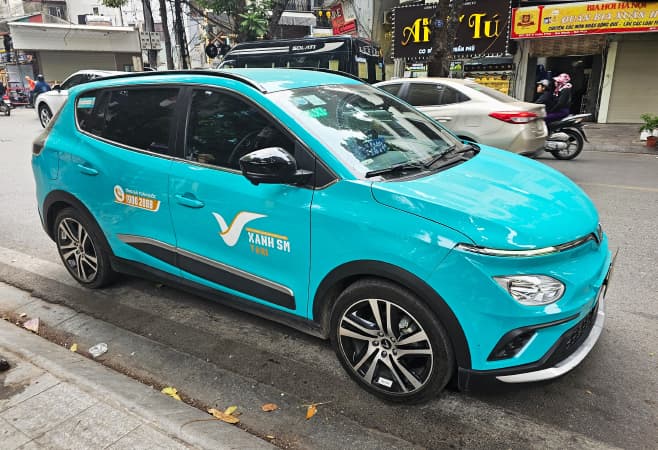
Modern Xanh SM electric taxi
Which option is best for you?
| Criteria | Grab | Be | Xanh SM |
| Popularity | Very high | High | Expanding |
| Motorbike Service | Available | Available | Not available |
| Electric Vehicles | Not available | Not available | 100% electric vehicles |
| Pricing | Dynamic (varies during peak hours) | Competitive | Fixed and transparent |
| Eco-Friendliness | Average | Average | Very high |
Airport transfers: Grab or Taxi?
Tourists often ask, “What’s the best way to get from the airport to my hotel in Vietnam?” The answer depends on your comfort level, luggage and time of arrival.
Grab at Airports:
Grab operates in most international and domestic airports in Vietnam, including Tan Son Nhat (Ho Chi Minh City), Noi Bai (Hanoi) and Da Nang International. Using Grab at airports is hassle-free if you’ve already set up the app. You’ll avoid language barriers and fare negotiations.
- Pros: Transparent pricing, digital tracking, less chance of scams
- Cons: You need a working internet connection (eSIM or local SIM recommended)
Traditional Taxis at Airports:
Taxis queue right outside airport terminals. Look for Mai Linh or Vinasun - official companies with well-maintained vehicles.
- Pros: No need for a smartphone, good for first-time travelers without data access
- Cons: Slightly higher rates, some drivers may overcharge if you appear unfamiliar
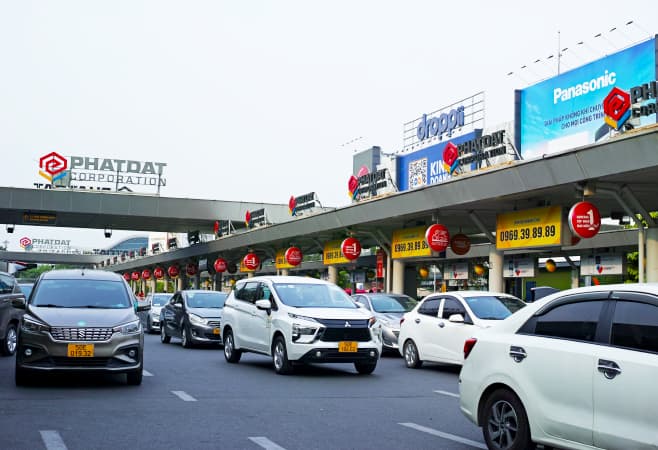
The technology taxi, cars, grab cars are running on street in downtown of Sai Gon
Language barrier issues
Vietnamese is a tonal language and even simple words can be misinterpreted. For tourists, this can be a challenge when communicating with taxi or Grab drivers.
How Grab helps:
- Destination Entry in English: You enter the location in the app, eliminating the need for verbal instructions.
- In-App Chat with Auto-Translate: Grab’s chat feature can translate English into Vietnamese and vice versa.
- Pre-saved Places: You can store your hotel address for easy rebooking.
Taxi workarounds:
- Show Your address in Vietnamese: Ask your hotel to write it down.
- Use Google Translate: A must-have tool when explaining your destination.
- Learn a Few Key Phrases:
- “Đi đến khách sạn này” = “Go to this hotel”
- “Bật đồng hồ” = “Please turn on the meter”
Tourists who prepare just a little bit ahead of time will find navigating Vietnamese transport surprisingly smooth.
Using GrabPay and payment options
When traveling abroad, handling money can be tricky. Thankfully, GrabPay - Grab’s integrated digital wallet - makes it easy for tourists to pay for rides without fumbling for cash or dealing with currency exchange issues.
Grab payment methods available:
- Cash: Always accepted, even when booking via app.
- Credit/Debit cards: Visa or MasterCard can be linked to your account.
- GrabPay wallet: A prepaid digital wallet useful for rides and GrabFood.
- MoMo and ZaloPay: Popular with locals, not ideal for short-term tourists.
Why tourists prefer GrabPay:
- Avoids language barrier at the end of the ride
- No need to carry small change
- Reduces risk of scams or fare disputes
To activate GrabPay, go to the “Payment” tab in the app, link your card and you’re good to go. However, make sure your card supports international transactions and has 3D secure verification enabled.
Best cities for using Grab in Vietnam
For tourists, not all cities offer the same level of Grab coverage. Here’s where Grab really shines:
| City | Availability | Notes |
| Ho Chi Minh City | Excellent | Ideal for GrabCar, GrabBike and GrabFood |
| Hanoi | Excellent | GrabBike helps avoid traffic in Old Quarter |
| Da Nang | Good | Smooth airport rides and city trips |
| Nha Trang | Moderate | Best during the day; taxis more common late night |
| Hoi An | Limited | Use taxis or hotel shuttles instead of Grab |
| Hue | Moderate | Good in city center; may struggle outside |
If you're exploring tourist-heavy zones, you’re likely to find Grab coverage reliable and prompt.
Alternatives to grab and taxis
Sometimes, Grab and Taxis aren’t the best or only choice. Here are some alternatives worth considering:
- Xe Om (Motorbike Taxi): Traditional, found on nearly every corner. Negotiate upfront.
- Bus: Cheapest option. Use the BusMap app to navigate local routes.
- Private Car Hire: Available through hotels or tour operators. Great for long excursions.
- Cyclo: Three-wheeled bicycle taxis, mostly for short scenic rides in tourist areas.
Each option has its own vibe. Choose based on your travel style and budget.
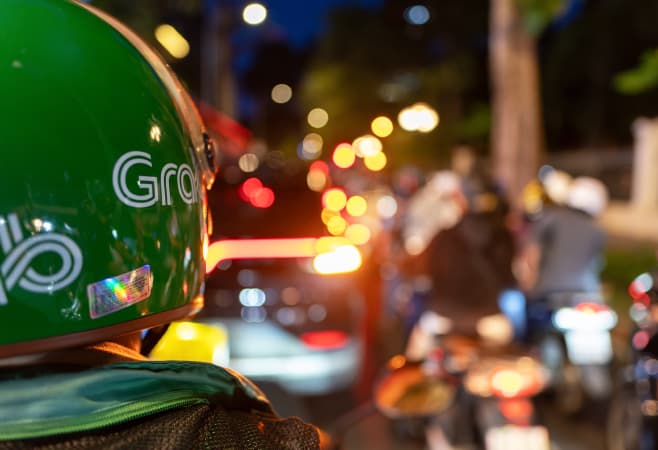
A GrabBike driver hands over a helmet to a solo traveler in Ho Chi Minh City
Conclusion: Grab and Taxi in Vietnam
When it comes to navigating Vietnam, Grab and Taxi services provide travelers with flexibility, affordability and peace of mind. Whether you’re zipping through Saigon on a GrabBike or relaxing in a Vinasun taxi in Hanoi, these transport options cater to every type of traveler.
Tourists will appreciate the balance between modern convenience and local flavor. With a little prep - downloading apps, brushing up on safety tips and understanding cultural norms - you’ll move through Vietnam like a seasoned pro.
Related Articles
- Grab and Taxi in Vietnam: Best transport options for visitors
- Ha Giang in Vietnam: Breathtaking loops & nature’s majesty
- Bun Cha Hanoi – Authentic Taste of Vietnam’s Iconic Dish
- Custom In Vietnam: A deep dive into Vietnamese traditions
- Retire in Vietnam: The ultimate guide for a dream retirement
- Trang An, Vietnam: A journey through Vietnam's natural wonder
- Vietnam Metro: The future of urban transportation in Vietnam
- Main districts of Ho Chi Minh city: Iconic landmarks & travel map
HOW CAN WE HELP?
APPLY WITH CONFIDENCE










